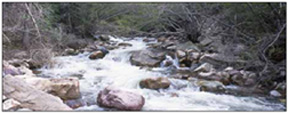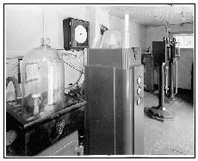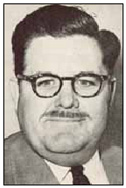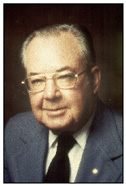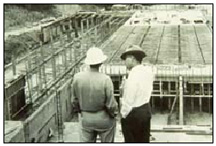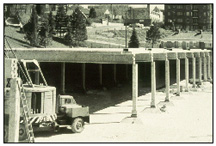Water Purification Program
November 18, 1999
Introduction
|
City Creek, a critical source of water supply was a popular recreation area for Salt Lake City residents. Located just minutes from downtown, it was heavily used. Despite the fact that it was chlorinated to destroy harmful bacteria, increasing Coliform bacteria levels alarmed health officials.
In 1947, the U. S. Public Health Service (“USPHS”), as part its newly adopted standards, evaluated Salt Lake City’s water supply. Their report focused mainly on the City’s watersheds and introduced the need to construct water treatment plants, cover distribution reservoirs and implement a cross connection program.
The urgency to take action was accentuated by the threat of the USPHS to pull Salt Lake City’s approved water rating. This would prevent interstate carriers from picking up water within Salt Lake City. City Creek Canyon was closed to the public in 1952, and plans proceeded to construct a water treatment plant. The pending adverse action would affect interstate commerce, but more importantly, it was a turning point that brought about a new era in water purification that ultimately would provide the public safer and cleaner drinking water.
This paper describes this era, which transformed Salt Lake City’s water system to a modern-day system. The transformation included source protection, purification technology, new federal and state regulations and most importantly able leaders to implement and complete the transformation.
Regulatory Mandate
On December 10, 1947 the USPHS, predecessor to the Environmental Protection Agency (EPA), issued a document entitled, “Report Covering Public Health Aspects of Salt Lake City’s Water Supply, With Reference to Watershed Developments, November 1947.” The Report recommended strong measures to protect and treat Salt Lake City’s water supply. Prepared by the USPHS’s District 8 located in Denver, Colorado, the report recommended restricting development on the watersheds of City Creek, Emigration Creek, Parleys Creek, Mill Creek, Big Cottonwood Creek and Little Cottonwood Creek until filtration of water supplies was developed.
The federal agency further recommended that recreational activities be limited to daytime recreational facilities only. Based on the above, it recommended the construction of hotels, resorts or developments with water carriage sewerage systems be prohibited on the canyon watersheds above any waterworks intake.
The report addressed water purification, “Salt Lake City should proceed at once with their plans to provide for complete rapid sand filtration and chemical disinfection of all of the city’s surface supplies including Deer Creek waters and all canyon sources.”
The report concluded by recommending that Salt Lake City increase the number of bacterial samples and consider break-point chlorination of all of
|
Watershed and Treatment Study Commissioned
About a year later, the Metropolitan Water District of Salt Lake City (“District”) conducted a study of all of the City’s watersheds, including the Provo River Project. On February 11, 1949 the Board of Directors of the District approved a contract with the engineering firm of Black & Veatch. Field work was accomplished between March 7, 1949 and July 1, 1950. As part of the study, a panel of water engineers was hired to oversee the project. The panel of engineers included J.A. Carollo of Phoenix Arizona, J.M. Montgomery of Pasadena, California and N.T. Veatch of Kansas City, Missouri. The panel personally inspected all of the watersheds during the 15-month study.
The work plan included bacterial testing, water chemistry analyses, water system operation practices, sanitary survey of the watersheds, cooperative efforts with the U.S Forest Service, Bureau of Reclamation and the State of Utah and a study of all of Salt Lake City’s water sources of supply.
The Report made the following recommendations:
1. Deer Creek Reservoir: The District, with the support of the state, should encourage the formation of a Wasatch County Department of Health to meet public health standards. Furthermore, Heber City should be completely sewered and a treatment facility constructed to serve the area.
2. City Creek: Bacterial contamination in City Creek was more than any other supply. During the 15-month study, the drinking water met the USPHS standards with chlorination; but this was determined to be a thin line of defense. It was recommended that stronger watershed protection measures be taken and that a 10 million gallon per day water treatment plant be constructed, including filtration.
3. Parleys Creek: The watershed above Mt. Dell was deemed to be better than City Creek, but nevertheless stronger measures were required. The quality of water from Mt. Dell was enhanced by the natural treatment within the reservoir. It was recommended that additional chlorination facilities be purchased and that trained personal be hired to operate the facility.
4. Mill Creek: The sanitary conditions of Mill Creek were the poorest of any of the canyons. Because of the high bacterial loading, Salt Lake City was not using this supply. It was recommended that sanitary facilities and controls be implemented to protect public health. In the future when the City filters all of its supply this source would be a valuable supply of water.
5. Big Cottonwood Creek: The canyon is affected by recreation throughout its entire length. The bacterial loading was somewhere between that of Mt. Dell Reservoir and City Creek. The report recommended that this canyon, perhaps more than any of the canyons, should have sanitation facilities that meet public health standards. Special efforts should be made to police the canyon and educate the public throughout the entire year. The report recommended improvements to the chlorination system and hiring personnel that are trained to operate the facility. It further recommended bypassing flows when the turbidity reached 10 parts per million. Lastly it was recommended that Argenta Dam be constructed to take advantage of the natural purification process in the reservoir.
6. Little Cottonwood Creek: Bacterial tests showed that this source of water was the best of all the canyons. It was recommended that new screens and chlorination structure be constructed.
7. Distribution Reservoirs: All of the reservoirs were open and subject to contamination. It was recommended that a program to cover all open reservoirs be initiated.
8. It was estimated to implement all of the recommendations that it would cost $2,286,750.00.
Except for City Creek, the Report did not recommend treatment plants for all of the City’s surface supplies, however in 1953, the decision was made by the State Department of Health and Salt Lake City to construct water treatment plants on all of the City’s canyon streams used for drinking water supply.
State of Utah Regulations
The Utah Water Pollution Board on November 19, 1954 adopted “The Standards of Quality And Regulations For Water Classifications,” based on the standards prescribed by the USPHS Drinking Water Standards of February 6, 1946 and the irrigation quality outlined in Chapter 5 of the U.S. Department of Agriculture “Agriculture Handbook No. 60,” issued February 1954.
On May 21, 1955, the State Department of Health adopted further regulations entitled, “Rules and Regulations Relating to Public Water Supplies.” The regulation addressed a wide range of standards, including required facility plan approvals, established rules for maintenance of records, water sampling of public water supplies, watershed standards, and setting the requirement that all public water supplies must meet USPHS bacteriological, chemical and physical water quality standards.
City Leaders Take Action
Newly appointed Commissioner Grant M. Burbidge (1951 –1958), filling the unexpired term of the late David A. Affleck, had the daunting problem of modernizing the City’s water system. In 1952 he appointed long time employee Charles W. Wilson as Superintendent to tackle the problem.
Wilson started his career at the age of 16 measuring water flows. Working his way through college and the Water Department, he became an acknowledged national leader and pioneer in modern waterworks and drinking water practices. His challenge in 1952 was to build water treatment plants, cover distribution reservoirs and implement watershed protection measures.
In 1952 City Creek Canyon was closed for public access in order to improve water quality and allow the canyon environs to rejuvenate. It was not reopened to the public until 1965.
In 1953 Salt Lake City sponsored legislation to levy a special four-mill tax to fund a “water purification program.” Sewage treatment was also to be financed through the special levy. The Legislature passed the legislation.
The Utah State Department of Health administered the state’s drinking water program. Salt Lake City officials worked closely with the state agency to implement the watershed and purification measures. The City Creek Water Treatment Plant was the first purification facility to be constructed.
|
In a meeting held on February 20, 1953 with Lynn M. Thatcher, Coordinator Sanitation and Hospital Services, Water Commissioner Burbidge and Superintendent Wilson agreed on a course of action. It was agreed that City Creek would stay closed until treatment facilities had been constructed. The completion of the treatment facility was contingent on favorable legislation permitting additional tax levies for treatment plant construction. Plans and specifications for the construction of the Big Cottonwood Water Treatment Plant were scheduled for completion by June 1, 1954. Watershed protection measures would be “stepped up,” and distribution reservoirs covered as rapidly as funds permitted. It was agreed that at least one reservoir would be covered in 1953, but the lack of funds prevented this from happening. Finally, a cross connection survey would be started in 1953.
Special four-mill levy taxes began to be collected in 1954. Records show that $904,249 in revenue was collected that year.
Between 1953 and 1955, $533,130 was expended on the City Creek Water Treatment Plant and over $100,000 in engineering costs for the Big Cottonwood Water Treatment Plant. In 1955, two steel tanks replaced the open Capitol Hills Reservoir at a cost of $69,733. This was the first uncovered reservoir to be corrected. Later in 1956, the Mt. Dell chlorination facility was constructed at a cost of $79,700. Likewise in 1956, four-mill levy funds were used to cover the 1300 East 1st South Reservoir at a cost of $162,791.
Four years into the program, Salt Lake City
|
In 1957, the Pleasant Valley Reservoir in City Creek Canyon was covered at a cost of $160,000; the Morris Reservoir in 1959 at a cost of $119,482 and the Park reservoir in 1961 at $225,216; and the Tanner Reservoir in 1967 at cost of $76,200. In 1968 the15th East reservoir was covered at a cost of $250,000. Over the years a total of nine reservoirs would be covered. The Baskin Reservoir was the last to be covered in 1974.
Provisional Approval
Salt Lake City’s water certification approval was extended each year. In an annual report to the U.S. Public Health Service, the Utah State Department of Health would recommend a “provisional rating” based on bacteriological sampling results and progress in meeting watershed protection and water purification objectives. These approvals continued through the 1960s and early 1970s when all of the objectives were finally completed.
Metropolitan Water District of Salt Lake City
In 1958, the Metropolitan Water District of Salt Lake City held a bond election to construct a water treatment plant near the mouth of Little Cottonwood Canyon. The treatment facility was strategically located to treat both Salt Lake City’s Little Cottonwood Creek water supply and the District’s Deer Creek water supply. The 100 million-gallon per day facility cost $7.5 million and was financed by a 20-year bond at an interest rate of 2.62 percent.
Cross Connection Ordinance Adopted
In 1960 Salt Lake City passed an ordinance establishing a cross-connection program under the Uniform Plumbing Code. A full time position was created and made responsible to carry out the program.
|
Four-mill Levy extended
In 1963, the 10-year time limit for the four-mill levy expired before the water and sewer programs were completed. It was necessary to request the legislature to extend the time period. The Women’s League of Voters championed the need to extend the tax levy to complete the work.
In a letter to the City Commission, the League stated, “The League will not support any action that might interfere with the orderly progress of either water purification or sewage treatment programs because both are vital to the health and growth of the community.”
Water Commissioner Conrad B. Harrison wanted to extend the levy for two additional years to complete the water purification and sewage treatment programs. Mayor J.Bracken Lee wanted the Metropolitan Water District of Salt Lake City to finance the remaining improvements through their surplus funds. Commissioner Harrison argued that this was not the proper function of the District and that the Water Purification Program was the responsibility of the City Commission.
In the end, with the support of the League of Women Voters, the City Commission moved forward to request the Legislature to extend the tax levy. As a result, later in 1963, Salt Lake City signed a $2,244,334 contract for the construction of the Parleys Water Treatment Plant. The Salt Lake Tribune in a December 14, 1963 article, wrote, “This is quite an achievement for both the city’s taxpayers and its water and other city officials. It is cause for real satisfaction and hearty congratulations – certainly including the taxpayers who over a period of nine years have put up approximately eight million dollars to finance the program.”
Achieving an Approved Rating
On June 5, 1975, Salt Lake City achieved its long sought goal of receiving an “Approved Rating,” freeing the city of the “provisional rating.” Lynn M. Thatcher, Deputy Director of Health, wrote in a letter, “This is to advise you that effective this date, following a final inspection of certain facilities made yesterday, we are assigning a
|
Charles W. Wilson spent much of his career in bringing this accomplishment to fruition. In implementing the improvements, he gained stature within and outside the water works community. His leadership in modernizing the water system and protecting the watersheds earned him the title “Mr. Water.” During those years, the various City Commissions lead by Water Commissioners’ Grant M. Burbidge, Conrad B. Harrison, Mayor Jake E. Garn, Tomas Hall and Herm Hogensen supported him in this effort.
During the years it took to implement the improvements, Salt Lake City met all drinking water standards. Extensive bacteriological testing results met federal and state drinking water standards. The state’s provisional approvals were based on meeting drinking water standards. The public was not at risk.
Conclusion
Today, Salt Lake City builds on the “Purification Program” legacy. Drinking water standards have become more stringent, requiring numerous treatment plant upgrades. Watershed protection and water treatment are considered the primary barriers preventing harmful organisms from reaching the customer’s tap. In 1996 Salt Lake City joined the EPA Partnership for Safe Water with the goal to optimize treatment processes to exceed federal drinking water standards. In 1999 all of the treatment plants met the requirements of the program.
Watershed protection activities have dramatically increased. During the 1980s a moratorium on new water sales agreements was enacted, a master plan was approved in 1988 and a canyon water sales ordinance in 1991. Domestic animals are prohibited in the watersheds and grazing has been eliminated. Within the Parleys, Mill Creek and Cottonwoods, the Salt Lake County Sheriff is under contract to enforce watershed ordinances. There are now three wilderness areas within the Wasatch Canyon watershed, and in 1999 a proposal was made to increase the acreage of all three.
Many of the early reservoirs that were covered have been either replaced or taken out of service. The Pleasant Valley and 13th East reservoirs are no longer in service because of structural problems. The 5th South 1500 East and Samuel Park reservoirs were totally replaced in 1997 and 1998 respectively. New decks have been constructed on the Marcus and Baskin reservoirs.
Salt Lake City is blessed with its mountain water supplies. Past City leaders developed the water; other’s built an infrastructure to deliver water to every tap; and still others built the purification system that today provides high quality drinking water to the City’s water service area. Subsequently, based on this strong foundation, Salt Lake City is ensured a bright and prosperous future.
Questions regarding this article can be directed to: leroy.hooton@ci.slc.ut.us
